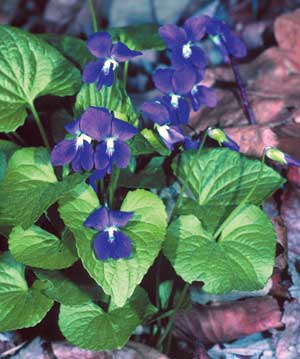Serendipity in the Woods: Author Carol Gracie Explores the History and Life of Wildflowers
by Kristin Nord
On the morning that the Bedford, New York Audubon group set forth on its field trip blustery winds and cold temperatures were conspiring; ephemerals that had been in bloom appeared to have shut up like drums, but would open as the day proceeded.
Outfitted in parkas and mittens and hats the hearty women scaling the hillsides were soon rewarded. There were meadows of trillium and foamflower, wild ginger, ginseng, and Solomon’s seal. There were Jack-in-the-pulpits, Mayapple, blue cohosh, and five varieties of violets, some 55 natives in all.
The naturalist Carol Gracie was at the helm, urging the group to slow down, and look closely at the natural feast spread out like a picnic before them. For these wildflowers have evolved to take advantage of the early spring sunlight that reaches the forest floor before the tree canopy has leafed out. With few exceptions, people must take to the woods to find them.
Gracie’s passion for wildflowers was kindled on childhood hikes with her father. As time went by, just knowing the names of wildflowers was not enough; “I wanted to know more about them, why they lived where they did, what insects visited them, how they got their names,” she writes. “As with people, plants become both more interesting and more memorable once you get to know them.”
Temperament, interest, and natural ability would lead to work at The New York Botanical Garden and a burgeoning later-life career as a writer and photographer. Gracie ran the BG’s children’s education and adult travel programs for many years and still exudes the patience and enthusiasm of a special teacher. Along the way she obtained her degree in botany, and spent about 25 years traveling and working in remote places with her husband, Scott Mori, a tropical botanist.
In Spring Wildflowers of the Northeast*, which garnered an honorable mention from the 2012 National Outdoor Book Awards, Gracie takes us on an armchair excursion as special as some of the tours she’s led in other years to many exotic places. The book follows on the heels of a field guide she coauthored with Steven Clemants and focuses on some of the Northeast’s most iconic natives.
Her book is a blend of natural and social history as well as an overview of how wildflowers figure in folklore, literature, and art history. She reports on the pests and pathogens, explores medicinal applications, and distills current findings from scientific journals into nuggets accessible to laymen. And because Gracie herself is a visual learner, she feels it crucial to use photographs to tell the story. In many of the more than 500 color photographs she employs a special macro lens to capture a natural world not visible to the naked eye.
Pages: 1 · 2
More Articles
- Ferida's Wolff's Backyard: The Snow Turned Into Snowy Rain As It Fell From The Trees. Still Lovely ...
- Ferida Wolff's Backyard: Awesome Goldfinches, Part of the Incredible Possibilities That Nature Might Offer
- Ferida Wolff's Backyard: Nature’s Jigsaw Puzzles
- Rebecca Louise Law: Awakening on View at Honolulu Museum of Art
- Ferida Wolff's Backyard: Dandelion Landing
- Ferida's Wolff's Backyard: A Nest!
- Ferida Wolff Writes: Winter to Spring
- Ferida's Wolff's Backyard: Geese Coming Home
- Ferida Wolff's Backyard: Lots and Lots of Boxelders
- Ferida Wolff's Backyard: Corn Rows and Hurricane Ida






